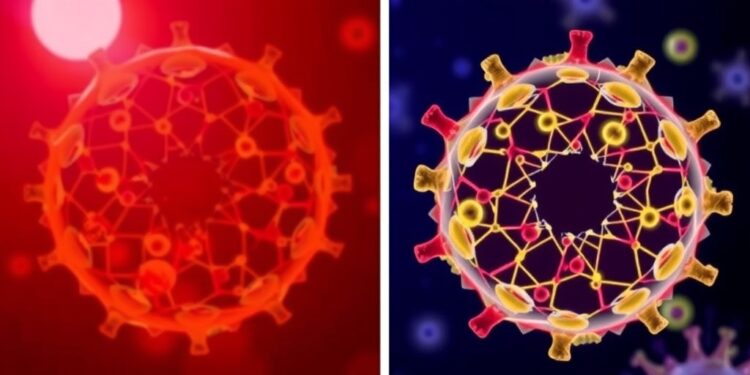A groundbreaking study unveiled at the ESCMID Global 2025 conference has spotlighted interleukin-6 (IL-6) as a potential keystone in the early detection of sepsis among vulnerable patient demographics, notably neonates, children, and pregnant women. The research distinguishes itself as the first to rigorously assess IL-6’s role in a diverse cohort, where the potential for rapid identification of this life-threatening condition is paramount. Sepsis, a severe consequence of the body’s response to infection, ranks as one of the leading causes of mortality worldwide, contributing to approximately 11 million deaths each year. This alarming statistic is particularly relevant for young children under five years of age and pregnant women, populations historically vulnerable to increased susceptibility and ongoing immunological changes.
The challenge of diagnosing sepsis significantly escalates during pregnancy, given the physiological alterations that can obscure initial symptoms. Most conventional diagnostic indicators—such as C-reactive protein (CRP) and procalcitonin (PCT)—tend to present limitations that can hinder timely intervention. These measures often lag in both response time and sensitivity, leading to potentially critical delays in treatment that compromise patient outcomes. Given the swift complications that can arise from sepsis—a condition that can spiral from inflammation to septic shock in a matter of hours—the urgent demand for biomarkers that facilitate faster and more precise diagnostics has never been clearer.
The innovative study assessed serial blood samples from a cohort of 252 patients, categorizing subjects into groups including 111 pediatric, 72 maternity, and 69 neonatal cases with suspected sepsis. This retrospective analysis aimed to examine the differentiation between bacterial and non-bacterial infections while also evaluating the physiological responses ranging from normal to the extremes of septic shock. A pivotal aspect of this investigation involved utilizing the Area Under the Receiver Operating Characteristic (AUROC) curve to analyze diagnostic accuracy across the different patient categories, where values close to 1 denote excellent performance.
Findings of the study revealed that IL-6 consistently outshines traditional sepsis biomarkers. The AUROC values highlighted IL-6’s exceptional discrimination ability, recording remarkable figures of 0.91 in pediatric cases, 0.94 in maternal patients, and 0.86 in neonatal cases. Such performance underscores IL-6’s capacity not just to detect infection but also to stratify varying severities of sepsis— a crucial element in formulating immediate treatment plans tailored to patient needs.
Sensitivity and specificity metrics further bolstered the case for IL-6 as a frontrunner in sepsis diagnostics. In pediatric and maternal patient populations, IL-6 achieved sensitivity levels soaring above 80%, with bacterial infection detection rates of 91% and 94%, respectively. Neonates presented a more intricate scenario; while IL-6 maintained an impressive specificity of 97.1%, the sensitivity dropped to 67.6%. This discrepancy can be attributed to the complexities inherent in neonatal sepsis diagnostics, where standardized definitions remain elusive.
Dr. Seán Whelan, the study’s lead author, elucidated that while traditional biomarkers such as CRP and PCT typically peak at 48 hours and 24 hours post-infection respectively, IL-6 shows a much quicker response trajectory. Its levels spike within 1-2 hours of infection onset, peaking at approximately six hours before initiating a decline by 24 hours. This characteristic response profile promotes IL-6 as a superior candidate for early sepsis identification, accentuating its utility in clinical settings.
Moreover, Dr. Whelan emphasized the relevance of IL-6 in current medical practices, noting its integration into routine diagnostics within institutions like the Rotunda Hospital and Children’s Health Ireland at Temple Street. The establishment of commercially viable testing methods that yield real-time results has alleviated some barriers to widespread IL-6 adoption. The COVID-19 pandemic catalyzed a significant uptick in IL-6 testing, showcasing its efficacy in monitoring inflammation levels among diverse patient populations.
The implications of these findings are substantial. Enhanced recognition of IL-6’s potential as a diagnostic biomarker could fundamentally reinterpret standard practices in sepsis management, particularly in high-risk groups predisposed to rapid clinical deterioration. The study underscores the pressing need for healthcare systems worldwide to adapt and adopt such advanced diagnostic measures to bolster patient safety and treatment efficacy.
With the promise of IL-6 as a diagnostic tool in sepsis detection, comprehensive clinical assessments in tandem with advanced biomarker utilization could considerably enhance clinical decision-making frameworks. The integration of this technique could reduce mortality and morbidity rates significantly among vulnerable patient populations, heralding a new era in sepsis management.
Understanding the gravity of sepsis’s impact on global health, this study serves as a crucial step forward in the quest for more effective, timely diagnostic mechanisms. The rise of IL-6 testing within clinical settings marks a pivotal moment in the relentless pursuit of transforming patient outcomes.
The results of this study will undoubtedly initiate dialogues among healthcare professionals regarding the optimization of sepsis diagnostic pathways and the continuous refinement of treatment regimens aimed at the populations that need it most.
In conclusion, the endorsement of IL-6 as a promising biomarker for sepsis diagnosis could catalyze a revolution in how we perceive and respond to this life-threatening condition, laying the groundwork for future explorations into innovative solutions tailored to the needs of those most at risk.
—
Subject of Research: Interleukin-6 as a diagnostic biomarker for sepsis in neonates, children, and pregnant women
Article Title: Breakthrough study identifies promising biomarker for early sepsis detection in neonates, children, and pregnant women
News Publication Date: [Insert Date]
Web References: [Insert URLs if applicable]
References: [Insert any additional references if applicable]
Image Credits: [Insert Image Credits if applicable]
Keywords: interleukin-6, sepsis, biomarkers, early detection, diagnostics, pediatric patients, maternal health, neonatal health, medical microbiology, clinical studies, inflammation.




